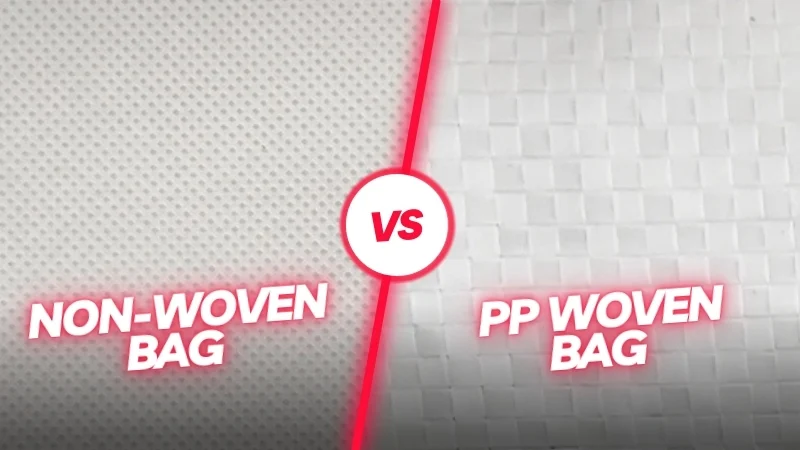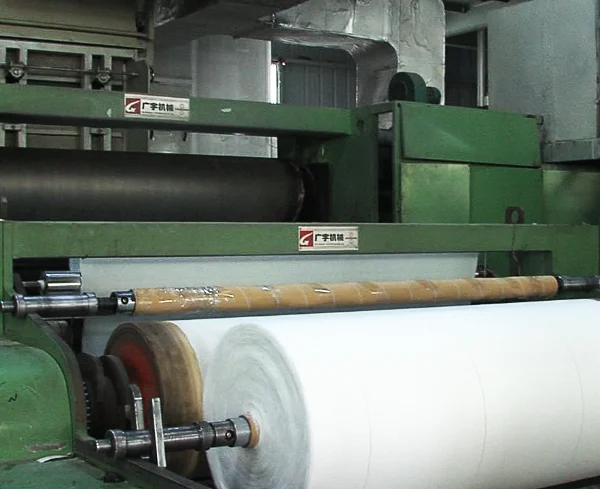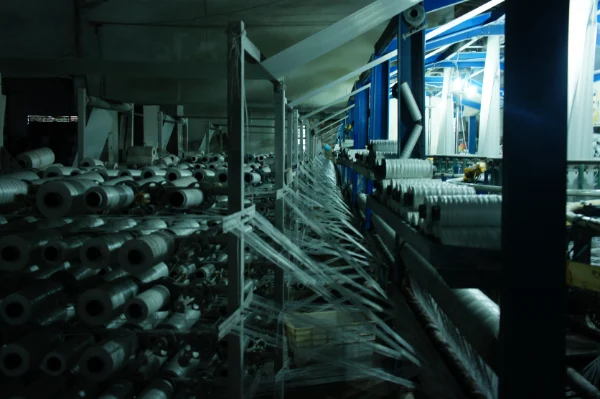Our Academy

In my work, clients often ask me about the difference between PP Non-Woven (PP non-woven fabric) and PP Woven (PP woven fabric) materials.
Since this is a common question, we believe many readers may have the same curiosity. Therefore, today, we will provide a detailed explanation on this topic.
Since our company mainly produces shopping bags, this article will compare the features and differences between these two materials from the perspective of shopping bags, without involving agricultural or industrial applications.
PP Non-Woven and PP Woven have the same raw material, both made from Polypropylene (PP).
Non-woven fabric is made by directly bonding polypropylene fibers, instead of traditional weaving or knitting methods. The process involves melting polypropylene pellets, extruding them into fibers, laying these fibers into a web-like structure, and bonding them together through heat, chemicals, or mechanical methods.


PP Woven fabric is produced by stretching polypropylene into flat strips (PP flat yarn) and then weaving them in a cross pattern to form a mesh structure. This weaving process gives it higher tensile strength and tear resistance, making it capable of carrying heavier weights and pressure. Basic PP woven fabric does not undergo lamination or coating. Its surface shows a clear woven texture, which provides some breathability, but its moisture resistance is relatively limited.
Non-woven fabric does not necessarily need lamination, while woven fabric typically requires lamination or coating.
Does Non-Woven Fabric Need Lamination?
Non-woven fabric does not necessarily require lamination. It can be directly printed with silk screen, heat transfer, or gravure printing, which simplifies the production process and reduces costs. Non-laminated non-woven bags are widely used in promotional bags, advertising bags, and disposable shopping bags, particularly suitable for mass production and short-term use.
However, if non-woven fabric needs to enhance durability, water resistance, or improve printing effects, it can be laminated. Laminated non-woven fabric feels firmer, has a smooth surface, and can support high-quality, full-color prints, but the cost will increase accordingly.


When PP woven fabric is made into shopping bags, it almost always needs lamination or coating. Due to the clear woven texture on the surface, if it is not laminated, the printed patterns will be unclear and uneven, and its water resistance is relatively poor. Therefore, a layer of PP film (glossy or matte) is usually applied to the surface, not only enhancing the vibrancy and clarity of the print but also improving the bag’s water resistance and durability.
| Category | Sub-category | Further Sub-division |
|---|---|---|
| Bags | Non-woven Bags | Laminated Non-woven Bags |
| Non-laminated Non-woven Bags | ||
| PP Woven Bags | Laminated Woven Bags |
Laminated PP non-woven bags are completely waterproof. True
Laminated PP non-woven bags achieve excellent waterproof properties due to the BOPP film layer applied during lamination.
All PP non-woven bags are equally suitable for heavy-duty use. False
PP non-woven bags are generally better for lighter loads, while PP woven bags are preferred for heavy-duty applications.
PP woven fabric has a much stronger load-bearing capacity than PP non-woven fabric because its interwoven structure provides higher tensile strength and tear resistance, making it suitable for carrying heavy items like rice bags, flour bags, wholesale market shopping bags, etc. Non-woven fabric, due to its fiber bonding structure, has a weaker load-bearing capacity and is more suitable for lightweight shopping bags or promotional bags. Laminated non-woven bags have improved load-bearing capacity, but they still do not match woven bags and are more suited for medium-weight items.
PP woven fabric, due to its interwoven structure, has high tear resistance and durability, making it suitable for long-term use without easily breaking or getting damaged. While PP non-woven fabric can also be used multiple times, especially laminated non-woven fabric, which greatly improves abrasion resistance and water resistance, its overall durability is still slightly inferior to woven bags, especially when carrying heavy items or during long-term use.
Non-laminated PP non-woven fabric has the lowest price, making it suitable for promotional bags or small gift bags, daily shopping bags. Laminated non-woven fabric has a higher cost due to the additional processing, bringing its price closer to that of PP woven fabric. Considering that woven fabric is thinner and denser than non-woven fabric, the shipping cost of woven bags is usually lower for the same quantity, meaning that after including shipping costs, laminated non-woven fabric might have an overall cost slightly higher than woven bags.
PP non-woven fabric, due to its fiber bonding structure, feels softer and has better flexibility and foldability, making it more suited for lightweight shopping bags and promotional bags. PP woven fabric is sturdier and less prone to deformation, although it still has some flexibility. However, compared to non-woven fabric, it is more rigid and suitable for shopping bags that require higher load-bearing capacity.
Non-woven fabric has a texture similar to canvas, giving it a breathable surface that looks and feels comfortable. On the other hand, PP woven fabric is made by interweaving warp and weft threads, and its surface is relatively flat.
Since woven fabric is not used for silk-screen or heat transfer printing, here we specifically compare laminated non-woven fabric and laminated woven fabric. Both are printed with patterns first on the film and then laminated onto the fabric. The printing effects on both materials are excellent, and they can both support highly detailed and colorful designs.
Both non-woven fabric and woven fabric have the same raw material, made from polypropylene (PP), which is recyclable. However, because most regions lack specific recycling facilities, recycling is difficult, and therefore, their environmental friendliness mainly lies in their reusability. Both non-woven and woven fabrics can be reused to extend their lifespan, reducing the waste from single-use plastic bags, thus achieving environmental goals.

PP woven bags are stronger and more durable than PP non-woven bags. True
PP woven bags have a higher strength and load-bearing capacity, making them suitable for heavy-duty applications.
PP woven bags are biodegradable and environmentally friendly. False
PP woven bags are made from polypropylene, a synthetic polymer, which is not biodegradable and persists in the environment.
In conclusion, non-woven fabric and woven fabric each have their unique advantages and suitable applications. Regular non-woven fabric, due to its softness, lightness, and low cost, is ideal for promotional bags, advertising bags, and disposable shopping bags. On the other hand, laminated non-woven fabric maintains the lightweight nature of non-woven fabric while adding water resistance and durability, making it suitable for applications that require higher-quality printing and packaging. In contrast, woven fabric, with its higher load-bearing capacity and durability, is more suitable for long-term use or carrying heavy items in shopping bags and packaging. Both materials have certain environmental benefits, and the choice depends on usage requirements, budget, and durability needs.
If you are looking for shopping bags for retail, promotions, or brand packaging, Yanxin Bag is a professional woven bag manufacturer and non-woven bag factory offering a wide range of custom shopping bag solutions. Whether you need PP woven bags or non-woven bags, we provide high-quality bulk production with flexible printing options to match your needs, budget, and brand identity.
Contact Yanxin Bag today to explore the most suitable eco-friendly bag solutions for your business.
Explore the Full Picture of Non-Woven Bags, from Basics to Customization
This all-in-one guide explains everything from the basics and types of non-woven bags to their pros, cons, and how customization works — a perfect follow-up for readers exploring material differences.
Curious How Non-Woven Bags Stack Up Against Paper? This One’s Clear-Cut
Beyond PP woven bags, paper is another common alternative. This article compares paper and non-woven bags in terms of usability, branding potential, and eco-friendliness to help you make a smarter packaging choice.
Unsure Which Printing Method Works Best? This Guide Lays It Out
While this article touches on print compatibility, this guide dives deeper into the pros and cons of key printing techniques — helping you choose the one that fits your design, volume, and budget needs.
Not Sure How to Use Non-Woven Bags? Here’s a Practical Guide
Once you’re clear on the materials, the next step is application. This article outlines real-world uses for non-woven bags across industries like retail, trade shows, and promotions — making material insights actionable.
Get a free quote and expert consultation today. Let's bring your brand vision to life.
1 Discover the importance of recyclability in reducing waste and promoting sustainability in various industries.
2 Discover the advantages of PP woven bags, including their durability and load-bearing capacity, perfect for heavy-duty use.
3 Explore the advantages of non-woven fabric, including its unique properties and applications in various industries.
Answer: PP woven bags are ideal for heavy-duty applications, while PP non-woven bags are perfect for shopping, promotional, or light storage needs.
Answer: They are made by bonding polypropylene fibers through heat, chemicals, or mechanical processes, avoiding traditional weaving methods.
Answer: No, PP woven bags are made from synthetic polymers and are not biodegradable.
Answer: They include Spunbond Non-Woven, Meltblown Non-Woven, SMS Non-Woven, and more.
Answer: PP non-woven bags usually deliver superior printing quality due to their smoother surface.
Answer: Yes, both PP woven and non-woven bags with lamination have excellent waterproofing properties.
Answer: PP woven bags are stronger and more durable, while PP non-woven bags are softer and more flexible.
Answer: Yes, laminating PP non-woven bags enhances their strength, durability, and waterproofing.

Order or no-order we are Always here to help you!
We will contact you within 1 working day, please pay attention to the email with the suffix “@yanxinbag.com”.
Order or no-order we are Always here to help you!
We will contact you within 1 working day, please pay attention to the email with the suffix “@yanxinbag.com”.